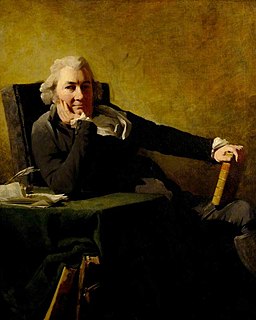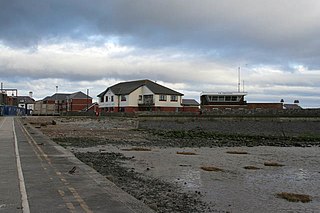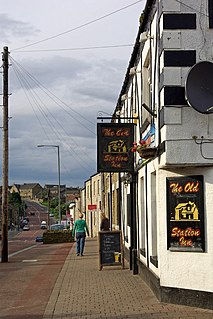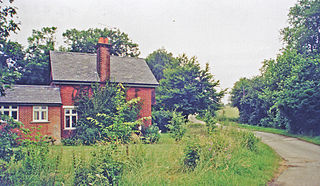Related Research Articles

Robert Graham, who took the name Bontine in 1770 and Cunninghame Graham in 1796, was a Scottish politician and poet. He is now remembered for a poem If doughty deeds my lady please, which was later set to music by his great-great-grandson, Rev. Malise Cunninghame Graham and also by Sir Arthur Sullivan.

Skewen railway station serves the village of Skewen, south Wales. It is located below street level at Station Road in Skewen, 210 miles 26 chains (338 km) from London Paddington. It is a stop on the South Wales Main Line, served by Transport for Wales Swanline regional trains between Swansea and Cardiff, which typically run every two hours. There is no Sunday service.

Roy Bridge railway station is a railway station serving the village of Roybridge in the Highland region of Scotland. This station is on the West Highland Line, between Tulloch and Spean Bridge, sited 87 miles 35 chains (140.7 km) from Craigendoran Junction, near Helensburgh. ScotRail manage the station and operate most services, along with Caledonian Sleeper.

Knott End railway station served Knott End on Sea in Lancashire, England, with a ferry service to Fleetwood. The station opened in 1908 and closed for passengers in 1930 and for freight in 1950.
Preesall railway station served Preesall in Lancashire, England, from 1908 to 1930, although goods continued until 1950.
Longton Bridge was a railway station on the West Lancashire Railway in England. It served the village of Longton.
The Glasgow to Aberfoyle Line was a railway line in Scotland, built in stages, leaving the Edinburgh and Glasgow Railway near Lenzie. Tourist traffic was a dominant part of the motivation for building the line, and road tours to the Trossachs from Aberfoyle formed a significant part of the traffic.

Gartmore is a village in the Stirling council area, Scotland. It is a village with a view of the Wallace Monument in Stirling, almost 25 miles away. Formerly in Perthshire, it is one mile from the A81 Glasgow to Aberfoyle road, three miles south of Aberfoyle. The Rob Roy Way walking route passes nearby.
Dukinfield and Ashton railway station served Dukinfield in Greater Manchester, England. The station was built at high level on a viaduct as it passed directly above Alma Bridge, King Street, Dukinfield. Access to the platforms was via an entrance in Cooper Street and ascending a staircase inside one of viaduct pillars. The viaduct extended from Whiteland, Ashton under Lyne, transversed the Tame Valley, passing over Crescent Road, King Street, Wharf Street, Charles Street and the Peak Forrest Canal before plunging under the Old Great Central line at Guide Bride and emerging at Audenshaw. The station was opened on 2 October 1893 by the London and North Western Railway, and was closed on 25 September 1950 by British Railways.
Furness Abbey is a former railway station in the Barrow-in-Furness area of the Furness Peninsula, England.

The Busby Railway is a short railway line built on the south side of Glasgow, connecting the small villages of Thornliebank, Giffnock, Clarkston and Busby and later Thorntonhall and East Kilbride with the city. It opened in two stages, in 1866 and 1868, and served industry and encouraged residential development.

Bradbury railway station served the village of Bradbury, County Durham, England from 1844 to 1950 on the East Coast Main Line.

Crow Park railway station served the village of Sutton-on-Trent, Nottinghamshire, England from 1882 to 1964 on the East Coast Main Line.

Boroughbridge railway station served the town of Boroughbridge, North Yorkshire, England from 1847 to 1964 on the Pilmoor, Boroughbridge and Knaresborough Railway.

Burton and Holme railway station served the village of Burton-in-Kendal, Westmorland, England, from 1846 to 1966 on the Lancaster and Carlisle Railway.

The Moray Coast Railway was a heavy rail route in Morayshire, Scotland. It was opened in three phases by the Great North of Scotland Railway (GNoSR) between 1884 and 1886. The line ran from the Banff, Portsoy and Strathisla Railway in Portsoy to the Morayshire Railway in Elgin. Trains were operated by the Great North of Scotland Railway until 1923, when the route was taken over by the London and North Eastern Railway (LNER). The LNER operated the route from 1923 until 1948 when Britain's railways were nationalised to form British Railways, who operated the route until its closure in 1968.

Tow Law railway station served the town of Tow Law, County Durham, England, from 1847 to 1965 on the Stanhope and Tyne Railway.
Thornley railway station served the village of Thornley, County Durham, England, from 1858 to 1952 on the Hartlepool Dock and Railway.

Mardock railway station served the village of Wareside, Hertfordshire, England, from 1863 to 1964 by the Buntingford branch line.
Bigby Road Bridge railway station served the town of Brigg, North Lincolnshire, England, from 1852 to 1882 on the Great Grimsby and Sheffield Junction Railway.
References
| Preceding station | Disused railways | Following station | ||
|---|---|---|---|---|
| Aberfoyle Line and station closed | North British Railway Strathendrick and Aberfoyle Railway | Buchlyvie Line and station closed |